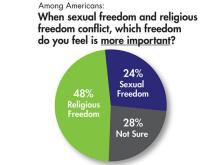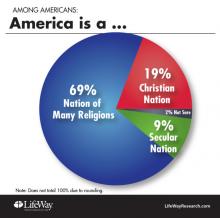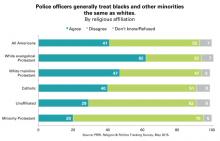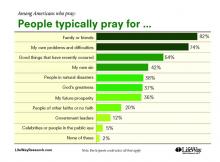statistics

The decline of Christianity in the U.S. has been documented by the Pew Research Center, which projects that Christianity may decline significantly over the next fourty years. On Sept. 13, Pew Research Center released four hypothetical scenarios that model what the religious landscape of the United States might look like if current demographic trends continue. The four models projected that the U.S. population who identify as Christian would decline from 64 percent in 2020 to between 35-54 in 2070. But that may not be a bad thing.

Domestic abuse is not only a public matter; it’s also a matter that affects the church. There are many ways people of faith can work to end domestic abuse, but the first way is by debunking harmful myths such as these.

Researchers also asked about what people think motivates religious believers who oppose sexual freedom. Almost half — 49 percent — said faith is the motivator. A fifth — 20 percent — said the motivator is hate. Another 31 percent were not sure.

Black motorists in Florida are twice more likely to be shot by police after being pulled over for a traffic violation than white motorists in Florida, reports the Tampa Bay Times in an online interactive, “If You’re Black.”
This statistic is part of a new investigative study by the paper of every police shooting that occurred in Florida from 2009-2014. The newspaper gathered data from autopsies, news articles, police reports, and subsequent lawsuits.

Americans are all for religious freedom — but disagree on who can claim it.
Diverse religious groups are recognized — but Christians and Jews are significantly more welcome than atheists, and many don’t see a welcome mat for Muslims. And not everyone means the same thing when speaking of a “Christian” nation.
So finds a new look at Americans’ religious self-image, detailed in a LifeWay Research survey released July 29.

The percentage of white Americans (46 percent) who believe blacks and other minorities receive equal treatment to whites in the criminal justice system is exactly the same as it was in 1992 — the year of the Rodney King riots in Los Angeles, according to the Public Religion Research Institute. In contrast, only 17 percent of black Americans and 39 percent of Hispanic Americans agree.

“Behind every number, there’s a story.”
That’s what inspires Maria Hinojosa, host and executive producer of NPR’s Latino USA, to investigate the dramatic demographic changes taking place in the United States in her new PBS show, America by the Numbers. In a nation that will be majority non-white by 2043, Hinojosa’s storytelling focuses largely on the oft neglected experiences of immigrants and people of color.
Unafraid of what mainstream media too often neglects, Hinojosa’s America by the Numbers brings to life the tensions at the heart of a rapidly diversifying America. She examines not only the unjust treatment of underrepresented communities by the American government but also the cultural conflicts inherent within these communities. For Hinojosa, the conflicts between tradition and progress, community and individuality, white and non-white are not to be avoided, but rather spotlighted.
Last week, Sojourners chatted with Hinojosa about America by the Numbers and the role the media can play in welcoming these demographic changes. This conversation has been lightly edited for length and clarity.

When Americans aren’t busy praying for themselves or their own needs — and most of them are — many are seeking divine intervention on behalf of a favorite sports team or the golden ticket in the lottery, according to a new survey.
About 13 percent of Americans who pray say they pray for sports teams, compared with about one in five (21 percent) who say they have prayed to win the lottery, the new survey from LifeWay Research suggests.
A survey earlier this year from Public Religion Research Institute suggested that more Americans (26 percent) pray for their sports team, while more than seven in 10 (73 percent) say they have never done this.
Some of LifeWay’s new survey’s main findings include:

More Americans today say religion’s influence is losing ground just when they want it to play a stronger role in public life and politics.
A new Pew Research Center survey finds 72 percent of Americans say religion’s influence is declining in society — the highest percentage since Pew began measuring the trend in 2001, when only 52 percent held that view.
“Most people (overwhelmingly Christians) view this as a bad thing,” said Greg Smith, associate director of Pew’s Religion & Public Life Project. “That unhappiness may be behind their desire for more religion and politics.”
Growing numbers want their politicians to pray in public and for their clergy to endorse candidates from the pulpit. And nearly half of Americans say business owners with religious objections to gay marriage should to be able to refuse wedding-related services to same-sex couples.
There are three ways to look at the findings, released Sept. 22:

The go-to number in American religion is “ASA” — average Sunday attendance. Or as an irreverent colleague put it, “Fannies in the pews.”
It’s a meaningless metric, but it’s easy. Open the doors on Sunday, wait for the stragglers, then dispatch ushers to count the house.
Entire methodologies for church development have been built around this number, as if fanny count dictated how a church should behave. Problem is, ASA isn’t a useful measure of quantity, and it says nothing about quality.
A much better quantitative measure would get at “touches,” that is, how many lives are being touched by contact with the faith community in its various Sunday, weekday, off-site and online ministries — and then, for a qualitative measure, asking how those lives are being transformed.
Those are difficult metrics to track, of course, and that’s why many congregations stick to ASA and shun the harder work of measuring outcomes and impact.

Putting Americans behind bars is becoming an increasingly lucrative business.

